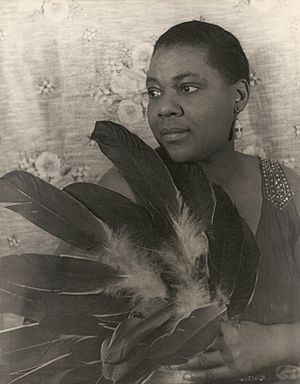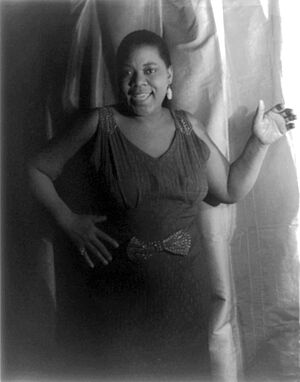Bessie Smith facts for kids
Quick facts for kids
Bessie Smith
|
|
|---|---|
 |
|
| Background information | |
| Born | April 15, 1894 Chattanooga, Tennessee, U.S. |
| Died | September 26, 1937 (aged 43) Clarksdale, Mississippi, U.S. |
| Genres | Blues, jazz |
| Occupation(s) | Singer |
| Years active | 1912–1937 |
| Labels | Columbia |
Bessie Smith (born April 15, 1894 – died September 26, 1937) was an American blues singer. Many people called her "The Empress of the Blues." She was very famous in the 1920s and 1930s.
A lot of people think she was one of the best singers of her time. She, along with Louis Armstrong, helped shape jazz music for future singers.
Contents
Bessie Smith's Early Life
Bessie Smith was born in Chattanooga, Tennessee. Her birthday was April 15, 1894.
Her parents were Laura and William Smith. Her father, William Smith, was a worker and a part-time Baptist preacher. He died before Bessie was old enough to remember him. By the time Bessie was nine, her mother had also died. Her older sister, Viola Smith, then took care of Bessie and her other brothers and sisters.
To help their poor family, Bessie and her brother Andrew started performing on the streets of Chattanooga. This is called Busking. Bessie sang and danced, and Andrew played the guitar. They often performed in front of the White Elephant Saloon. This was in the middle of Chattanooga's African-American neighborhood.
In 1904, Bessie's oldest brother, Clarence, left home. He joined a small traveling show owned by Moses Stokes. Clarence's wife, Maud, later said that Bessie would have gone with him if she had been old enough.
In 1912, Clarence came back to Chattanooga with the Stokes show. He helped Bessie get an audition. She got a job as a dancer. She was not hired as a singer because the show already had a singer named Ma Rainey.
By the early 1920s, Bessie Smith was starring in a musical called How Come?. She performed with Sidney Bechet. The musical even went to Broadway. Smith had a disagreement with the show's producer. She was replaced by another singer, Alberta Hunter. Smith then went back to Philadelphia, where she lived. She met and married a security guard named Jack Gee on June 7, 1923. Around this time, Smith made her first song recordings with Columbia Records.
Smith became the biggest star on the black Theater Owners Booking Association (T.O.B.A.) circuit. She had a show with many performers. She became the highest-paid black entertainer of her time. Jack Gee liked the money she earned. But he did not like her show business life. Smith and Gee later separated, but they never got divorced. Smith then lived with Richard Morgan, who was an old friend. He was also the uncle of jazz musician Lionel Hampton. Smith and Morgan stayed together for the rest of her life.
Bessie Smith's Music Career
Ma Rainey helped Bessie Smith become a better performer. But Rainey did not teach her how to sing. Smith started her own act around 1913. She performed at Atlanta's "81" Theatre. By 1920, she was well-known in the South and along the Eastern Seaboard.
In 1920, a singer named Mamie Smith recorded a song called "Crazy Blues." This was one of the first blues songs recorded by an African-American singer. It became very popular. The music industry then realized that many black people would buy blues records. Bessie Smith signed with Columbia Records in 1923. The record label decided to create a special series of "race records."
Her first recording was a combination of "Gulf Coast Blues" and "Downhearted Blues." These songs were very popular. Smith became a top performer on the black T.O.B.A. circuit. She was its main attraction in the 1920s. She worked very hard, performing in theaters during the winter. She toured for the rest of the year. She became the highest-paid black entertainer of her time. Someone from Columbia Records gave her the nickname, "Queen of the Blues." Soon, the press started calling her the "Empress of the Blues."
She made about 160 recordings for Columbia. She often performed with other famous musicians. These included Louis Armstrong, James P. Johnson, Joe Smith, Charlie Green, and Fletcher Henderson.
How Bessie Smith Died
On September 26, 1937, Bessie Smith was badly injured in a car accident. She was traveling between Memphis, Tennessee, and Clarksdale, Mississippi. Her boyfriend, Richard Morgan, was driving. People think he might have fallen asleep. Or he might not have seen a slow-moving truck in front of him. Tire marks showed that Morgan tried to drive around the truck. But he hit the back of the truck very fast.
Smith was in the passenger seat and was hurt the most. Morgan did not have serious injuries. A doctor was one of the first people to see her after the crash. He said she had a bad arm injury and lost a lot of blood. She also had serious injuries to her side. She was in shock.
An ambulance took Smith to Clarksdale's Afro-American Hospital. Her right arm was amputated (taken off). She did not wake up and died that morning. After she died, some people said that a hospital for white people would not treat her. However, in those days, an ambulance driver would never have taken a black person to a "Whites only" hospital.
Awards and Honors for Bessie Smith
Grammy Hall of Fame
Three of Bessie Smith's recordings were added to the Grammy Hall of Fame. This award started in 1973. It honors recordings that are at least 25 years old. These recordings must have "qualitative or historical significance."
| Bessie Smith: Grammy Hall of Fame Award | ||||
|---|---|---|---|---|
| Year Recorded | Title | Genre | Label | Year Inducted |
| 1923 | "Downhearted Blues" | Blues (single) | Columbia | 2006 |
| 1925 | "St. Louis Blues" | Jazz (single) | Columbia | 1993 |
| 1928 | "Empty Bed Blues" | Blues (single) | Columbia | 1983 |
National Recording Registry
In 2002, Smith's recording of "Downhearted Blues" was added to the National Recording Registry. This is done by the National Recording Preservation Board of the Library of Congress. The board chooses recordings each year that are "culturally, historically, or aesthetically significant."
"Downhearted Blues" was also on the list of Songs of the Century. This list was made by the Recording Industry of America and the National Endowment for the Arts in 2001. It was also in the Rock and Roll Hall of Fame's 500 songs that helped create rock 'n' roll.
Other Awards
| Year Inducted | Category | Notes |
|---|---|---|
| 2008 | Nesuhi Ertegun Jazz Hall of Fame | Jazz at Lincoln Center, New York |
| 1989 | Grammy Lifetime Achievement Award | |
| 1989 | Rock and Roll Hall of Fame | "Early influences" |
| 1981 | Big Band and Jazz Hall of Fame | |
| 1980 | Blues Hall of Fame |
In 1984, Bessie Smith was added to the National Women's Hall of Fame.
U.S. Postage Stamp
The U.S. Postal Service released a 29-cent special postage stamp honoring Bessie Smith in 1994.
Images for kids
-
Portrait of Smith by Carl Van Vechten
See also
 In Spanish: Bessie Smith para niños
In Spanish: Bessie Smith para niños




